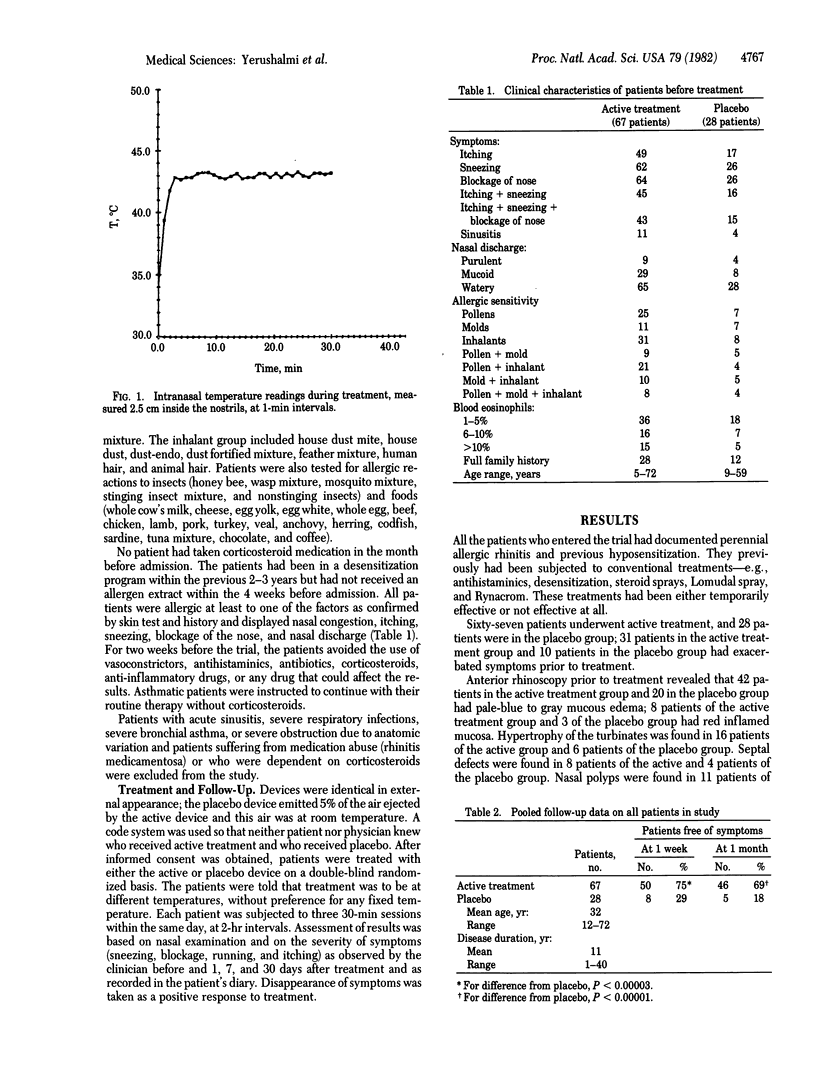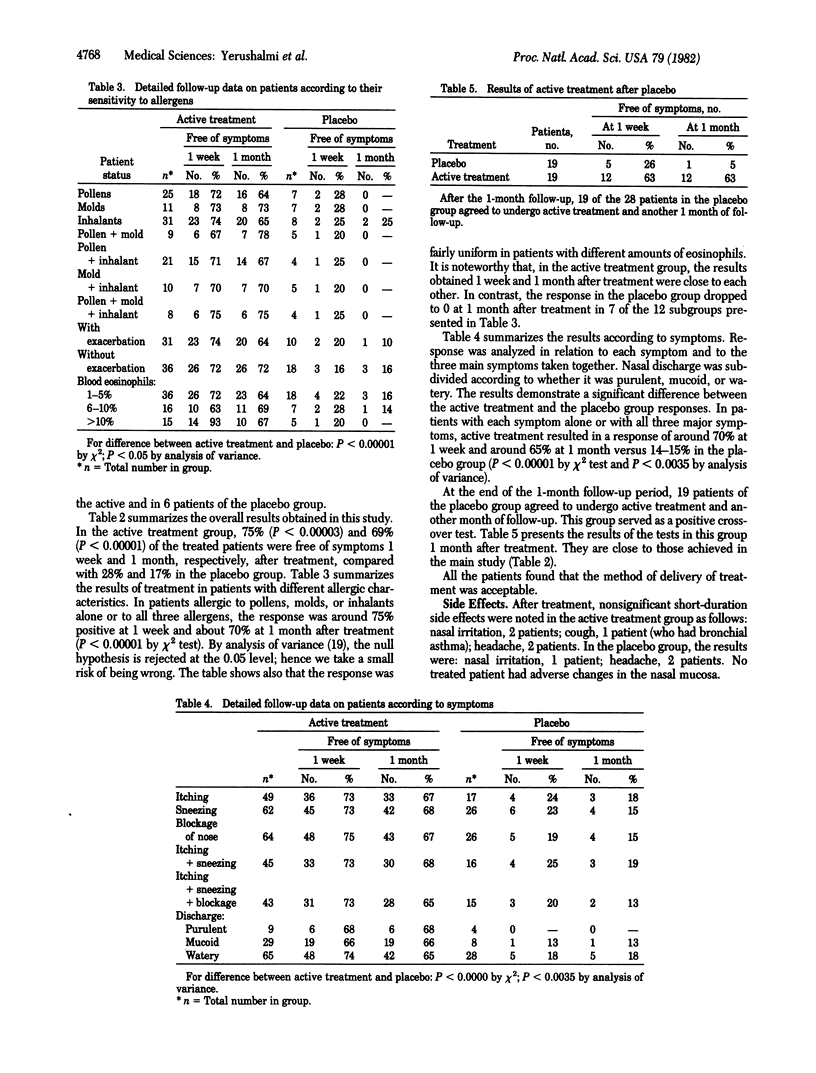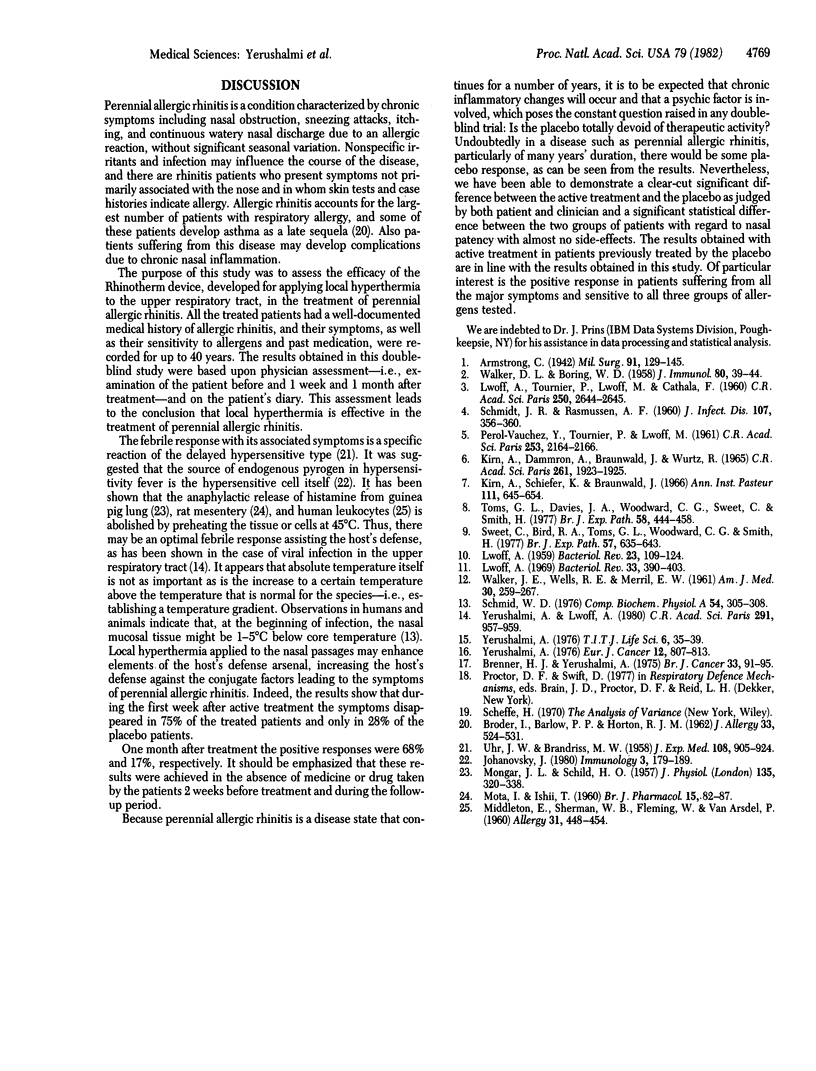Abstract
Ninety-five patients with documented perennial allergic rhinitis have been treated with local hyperthermia of the nasal passages in a randomized double-blind trial. The treatment consisted of one series of three 30-min insufflations of humidified air at 43 degrees C at a 2-hr interval. In the active treatment group, 75% (P less than 0.00003) and 68% (P less than 0.00001) of the patients were free of symptoms 1 week and 1 month, respectively, after treatment, compared with a 28% and 17% response in the placebo group. We conclude that local hyperthermia is effective in the treatment of perennial allergic rhinitis.
Full text
PDF



Selected References
These references are in PubMed. This may not be the complete list of references from this article.
- BRODER I., BARLOW P. P., HORTON R. J. The epidemiology of asthma and hay fever in a total community, Tecumseh, Michigan, II. The relationship between asthma and hay fever. J Allergy. 1962 Nov-Dec;33:524–531. doi: 10.1016/0021-8707(62)90020-5. [DOI] [PubMed] [Google Scholar]
- Brenner H. J., Yerushalmi A. Combined local hyperthermia and x-irradiation in the treatment of metastatic tumours. Br J Cancer. 1976 Jan;33(1):91–95. doi: 10.1038/bjc.1976.9. [DOI] [PMC free article] [PubMed] [Google Scholar]
- JOHANOVSKY J. Production of pyrogenic substances in the reaction of cells of hypersensitive guinea pigs with antigen in vitro. Immunology. 1960 Apr;3:179–189. [PMC free article] [PubMed] [Google Scholar]
- Kirn A., Dammron A., Braunwald J., Wurtz R. Relation entre la fièvre et la survie des lapins infectés avec le virus vaccinal. C R Acad Sci Hebd Seances Acad Sci D. 1965 Aug 23;261(8):1923–1925. [PubMed] [Google Scholar]
- Kirn A., Schieffer K., Braunwald J. L'hyperthermie provoquée au cours de l'encéphalite à virus vaccinal de la souris. Mécanisme de son action. Ann Inst Pasteur (Paris) 1966 Dec;111(6):645–654. [PubMed] [Google Scholar]
- LWOFF A. Factors influencing the evolution of viral diseases at the cellular level and in the organism. Bacteriol Rev. 1959 Sep;23(3):109–124. doi: 10.1128/br.23.3.109-124.1959. [DOI] [PMC free article] [PubMed] [Google Scholar]
- Lwoff A. Death and transfiguration of a problem. Bacteriol Rev. 1969 Sep;33(3):390–403. doi: 10.1128/br.33.3.390-403.1969. [DOI] [PMC free article] [PubMed] [Google Scholar]
- MONGAR J. L., SCHILD H. O. Effect of temperature on the anaphylactic reaction. J Physiol. 1957 Feb 15;135(2):320–338. doi: 10.1113/jphysiol.1957.sp005713. [DOI] [PMC free article] [PubMed] [Google Scholar]
- PEROL-VAUCHEZ Y., TOURNIER P., LWOFF M. [Attenuation of the virus of encephalomyocarditis of the mouse by culture at low temperature. Influence of hypo- and hyperthermia on the course of the experimental disease]. C R Hebd Seances Acad Sci. 1961 Nov 6;253:2164–2166. [PubMed] [Google Scholar]
- SCHMIDT J. R., RASMUSSEN A. F., Jr The influence of environmental temperature on the course of experimental herpes simplex infection. J Infect Dis. 1960 Nov-Dec;107:356–360. doi: 10.1093/infdis/107.3.356. [DOI] [PubMed] [Google Scholar]
- Schmid W. D. Temperature gradients in the nasal passage of some small mammals. Comp Biochem Physiol A Comp Physiol. 1976;54(3):305–308. doi: 10.1016/s0300-9629(76)80116-8. [DOI] [PubMed] [Google Scholar]
- Sweet C., Bird R. A., Toms G. L., Woodward C. G., Smith H. Thermal stability and interaction with ferret inflammatory exudates of two clones of influenza virus of differing virulence for both ferrets and man. Br J Exp Pathol. 1977 Dec;58(6):635–643. [PMC free article] [PubMed] [Google Scholar]
- Toms G. L., Davies J. A., Woodward C. G., Sweet C., Smith H. The relation of pyrexia and nasal inflammatory response to virus levels in nasal washings of ferrets infected with influenza viruses of differing virulence. Br J Exp Pathol. 1977 Aug;58(4):444–458. [PMC free article] [PubMed] [Google Scholar]
- UHR J. W., BRANDRISS M. W. Delayed hypersensitivity. IV. Systemic reactivity of guinea pigs sensitized to protein antigens. J Exp Med. 1958 Dec 1;108(6):905–924. doi: 10.1084/jem.108.6.905. [DOI] [PMC free article] [PubMed] [Google Scholar]
- WALKER D. L., BORING W. D. Factors influencing host-virus interactions. III. Further studies on the alteration of Coxsackie virus infection in adult mice by environmental temperature. J Immunol. 1958 Jan;80(1):39–44. [PubMed] [Google Scholar]
- WALKER J. E., WELLS R. E., Jr, MERRILL E. W. Heat and water exchange in the respiratory tract. Am J Med. 1961 Feb;30:259–267. doi: 10.1016/0002-9343(61)90097-3. [DOI] [PubMed] [Google Scholar]
- Yerushalmi A. Calculation of intratumor temperature in a heated superficial tumor. TIT J Life Sci. 1976;6(1-2):35–39. [PubMed] [Google Scholar]
- Yerushalmi A., Lwoff A. Traitement du coryza infectieux et des rhinites persistantes allergiques par la thermothérapie. C R Seances Acad Sci D. 1980 Dec 8;291(12):957–959. [PubMed] [Google Scholar]
- Yerushalmi A. Treatment of a solid tumor by local simultaneous hyperthermia and ionizing radiation: Dependence on temperature and dose. Eur J Cancer. 1976 Oct;12(10):807–813. doi: 10.1016/0014-2964(76)90095-5. [DOI] [PubMed] [Google Scholar]


